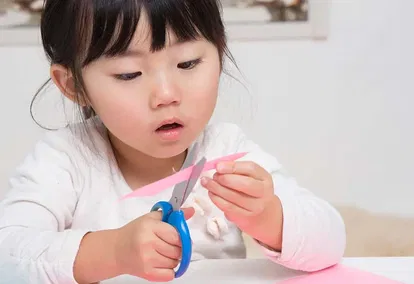
Chunky crayons, blunt scissors, stubby pencils, washable markers and paints. Such is the realm of preschoolers as they move from using large muscles to small muscles and develop the fine motor skills needed to do countless everyday tasks for themselves.
Fine motor skills involve the use of the smaller muscles of the hands. Some activities may include using crayons, scissors, blocks, or tongs.
The interest area activities in Mission Friends Leader are created to help preschoolers progress spiritually, relationally, emotionally, and developmentally.
These activities also crucially provide the opportunity for preschoolers to explore, practice, and gain mastery over fine motor skills that help them as they connect with the world and lives of missionaries, missions areas, and Christian concept areas covered in Mission Friends.
Fine Motor Skills in Interest Area Activities
In Art, when you allow preschoolers to use glue sticks or liquid glue, the experience will go beyond just gluing items together. Preschoolers feel independent when they are allowed to use glue with their own hands. Their hands use new muscles as they build strength and control. “Dot, dot. Not a lot.” This is a helpful phrase when using liquid glue. As with all things in a preschool classroom, the use of age-appropriate resources will allow the preschooler to be independent and grow in confidence as they complete a task by themselves.
In Blocks, provide a variety of sizes, textures, and types of blocks so preschoolers can build a home, church, city street, or a playground. Manipulating blocks while they build enhances fine motor skills as preschoolers grasp and place blocks, all the while connecting the activity to the missions area.
For Books, set out a variety of age-appropriate books pertaining to the missions area. Looking at and holding books engages fine motor skills as preschoolers turn pages, point, and trace. Making and using hand or finger puppets in this area also encourages creativity as they interact and learn about missions.
The Homeliving area incorporates many ways to use fine motor skills. Setting a table, cooking a pretend meal, sorting foods, pretending to drive, or putting on dress-up clothes all require fine motor skills. Don’t underestimate these activities. Each activity will give preschoolers the opportunity to practice fine motor skills.
When planning for Music and Movement, sing songs and fingerplays that encourage preschoolers to clap, snap fingers, tap different body parts, and touch opposing hands and fingers together. Both large and fine motor skills are engaged as preschoolers sing and move.
Furnish a space for Nature with leaves, sticks, pebbles, sand, or small nature objects to promote creativity and an appreciation for the missions area. Allow preschoolers to manipulate the nature items with their fingers so they can learn through the use of fine motor skills.
Preschoolers exercise fine motor skills when they enjoy Puzzles and Manipulatives. The small hand and wrist muscles, as well as hand-eye coordination, grow when preschoolers work puzzles, thread beads on string, or create with play dough.
As you plan activities for preschoolers, remember the activities are easy for you, an adult. But preschoolers have smaller, less developed hands and muscles. An important task of being a preschooler is to practice and develop new skills for their small hands.
by Beth Campbell